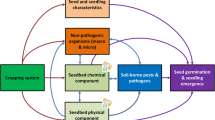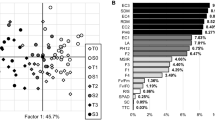Abstract
The relation of first shoot emergence in various tree species (birch, beech, oak and spruce) to meteorological parameters was studied on the basis of phenological and meteorological observations at five locations in Slovenia during 1967–1986. A physical model was developed using tree branch temperature obtained by the energy balance equation. The gained linear dependence of first shoot emergence on effective tree branch temperature was compared with the results obtained by multiple regression analysis among first shoot emergence, effective temperature, global radiation, wind velocity and precipitation. A new method was developed to define the proper biological temperature threshold which was used for effective temperature calculations. Results of the physical model and of the multiple regression analysis are statistically significant and give similar correlations between first shoot emergence and meteorological parameters.
Similar content being viewed by others
References
Anonymous (1988) Genstat 5, Reference manual Oxford University Press, Oxford
Gates DM, Papian VE (1971) Atlas of energy budgets of plant leaves. Academic Press, New York
Hočevar A (1964) Über dem komplexen Einfluss des Wetters auf die Vegetationsentwicklung. Carinthia II, Villach 24:126–130
Hočevar A (1968) The growth and development of plants as a function of the complex of atmospheric factors of the environment. Orszagos Meteorologai Intezet, Idojaras, 3:153–156
Hočevar A (1973) Prispevek k poznavanju temperatur drevesne skorje osamljene lipe ob spomladanskem enakonocju. Gozdarski vestnik, Ljubljana, 31(5):198–202
Ihne E (1884) Geschichte der pflanzenphänologischen Beobachtungen in Europa nebst Verzeichnis der Schriften, in welchen sie niedergelegt sind. In: Beitrage zur Phänologie. J Rickersche Buch, Giessen, Germany
Lieth H (ed) (1974) Phenology and seasonality modeling. Chapman-Hall, London
Linnacus C von (1751) Philosophia botanica. Kiesewetter, Stockholm
Obrebska SB (1981) An approach to the pheno-climatic typology and its pattern in the mountainous areas of Poland. Int J Biomereorol 25: 269–279
Schnelle F (1955) Pflanzen phenologie. Academische Verlagsgesellschaft, Geest-Portig KG, Leipzig
Segula-Ilič A (1990) Model ozelenitve nekaterih drevesnih vrst v Sloveniji glede na meteorološke parametre okolja. Univerza v Ljubljani Fakultera za naravoslovje in tehnologijo, Katedra za meteorologijo, Ljubljana
Venckevič GZ (1958) Poljoprivredna meteorologija. Savezna komisija za vodoprivredu. Kartografski zavod Geokarta, Beograd
Veselič Ž (1990) Olistenje bukve na Snežniško-javorniškem masivu. Univerza v Ljubljani Biotehniška fakulteta, VTOZD za gozdarstvo, Ljubljana
Yasuyuki A Y Omoto (1990) Estimation of blooming date forPrunus yesloensis using DTS combined with chill-nuit accumulations. J Agric Meterol 45: 243–249
Author information
Authors and Affiliations
Rights and permissions
About this article
Cite this article
Hočevar, A., Šegula-Iliě, A. Modelling relation of first shoot emergence in various tree species to meteorological parameters in Slovenia. Int J Biometeorol 34, 221–225 (1991). https://doi.org/10.1007/BF01041832
Received:
Revised:
Accepted:
Issue Date:
DOI: https://doi.org/10.1007/BF01041832




